Top Tier CPU Air Coolers Q3 2015: 9-Way Roundup Review
by E. Fylladitakis on July 6, 2015 8:00 AM ESTThe Phanteks PH-TC14PE
Phanteks is another world-renowned CPU cooler manufacturer, whose high performance designs made them widely known very quickly. Aside from coolers and fans, the company is now active in the field of PC cases as well. For the means of this review, Phanteks supplied us with the PH-TC14PE, their largest and most popular CPU cooler. The PH-TC14PE actually is over two years old, making it the oldest design in this roundup review.
Phanteks supplies the PH-TC14PE in a large cardboard box with an abstract design showcasing the color variations of the cooler. Inside the box, the cooler is well protected within a polyethylene foam shell and the bundled items are secured in small boxes. Aside from the hardware necessary for the mounting of the cooler, Phanteks also provides a tube of quality thermal grease, six anti-vibration rubber strips for the fans, a fan power cable splitter, a fan speed reducer. They also provide six wire clips and twelve plastic fan clip adaptors, for the installation of up to three fans onto the cooler's body.
The PH-TC14PE is a very large symmetric dual tower cooler. The fronts of the fins form small circular notches, with the exception of the top fin that is straight and serves as a cover for the heatpipes as well. One of its prominent features is instantly apparent, which is the colored fins. There are five color variations of the PH-TC14PE and we received the black version. Phanteks calls this "Physical Antioxidant Thermal Shield" (or Physical Antioxidant Thermal Spraying - we found both in the company's texts) and claims that it enhances thermal performance by both increasing the dissipation rate of the heatsink itself and decreasing the radiation absorption rate from other heat sources. The fins are soldered on the heatpipes with another patented method that Phanteks calls "Cold Plasma Spraying Coating", which supposedly increases the heat transfer rate between the copper heatpipes and the aluminum fins.
Phanteks provides two of their own PH-F140 140 mm fans with the PH-TC14PE. The company loves abbreviations, so the PH-F140 have "Updraft Floating Balance (U.F.B)" bearings, "Maelstrom Vortex Booster (M.V.B)" blades and "Maelstrom Air-Fort Optimization (M.A.F.O)" drive systems. Other than the fancy names, no real technical data or schematics of these technologies can be found. All we are left with is their standard manufacturer specifications, which indicate a maximum speed rating of 1300 RPM (1200 RPM in PWM mode). The design of the wire clips allows the fans to be moved upwards by several centimeters, providing clearance to RAM modules and heatsinks that would otherwise be blocked, assuming that the case is wide enough of course.
The base of the PH-TC14PE is simplistic, virtually meant only to provide mechanical retention for the installation on a CPU. Five thick 8 mm heatpipes run through the base and to both fin arrays on either side. The copper bottom half of the base and the heatpipes are nickel-plated, with the contact surface polished fairly well but not down to a perfect mirror finish. Slight machine marks can be seen on the contact surface but there are no major imperfections to speak of.


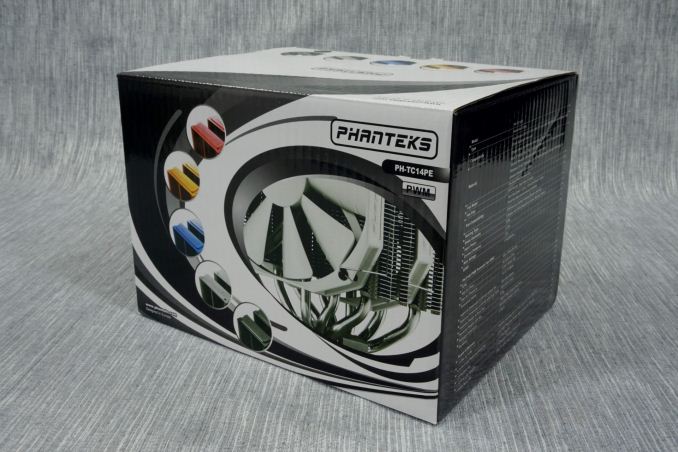
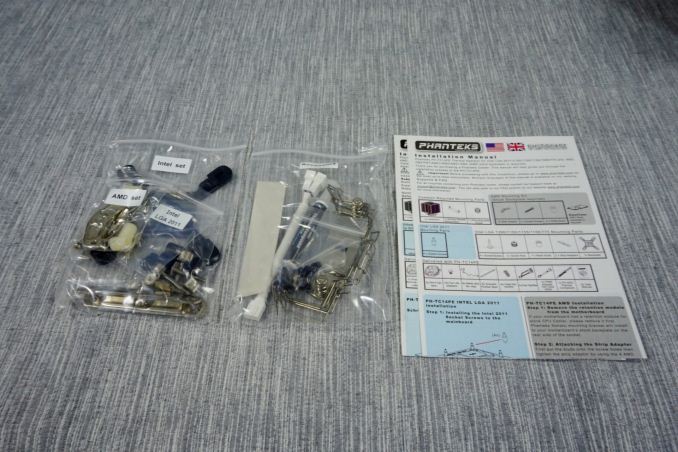
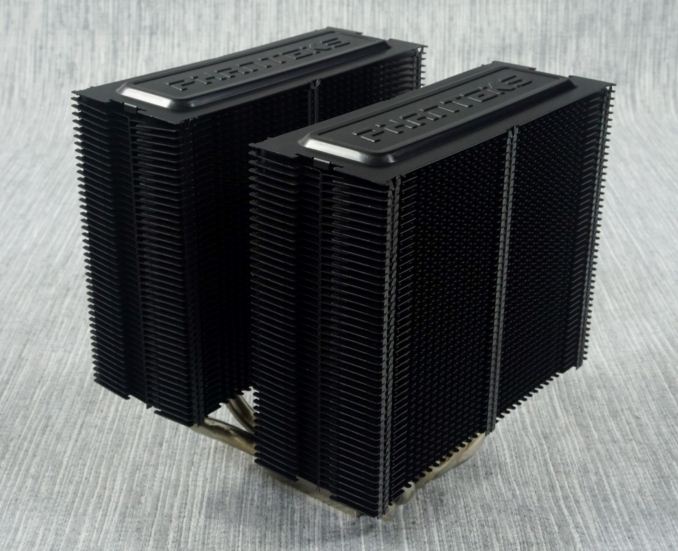
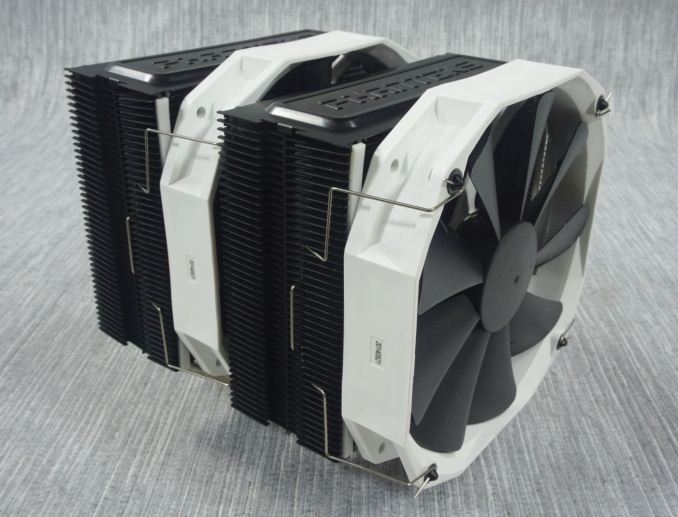
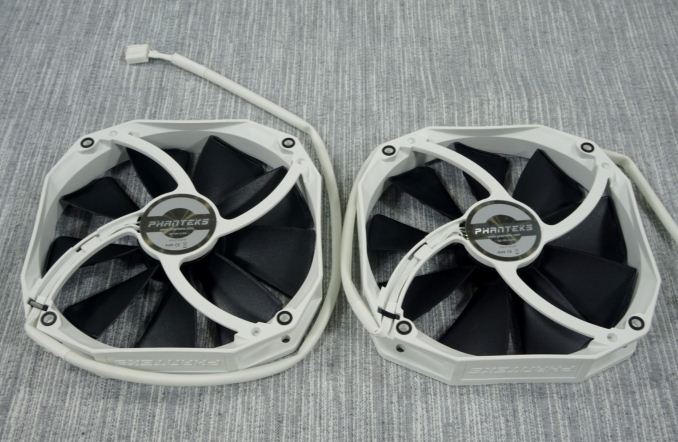
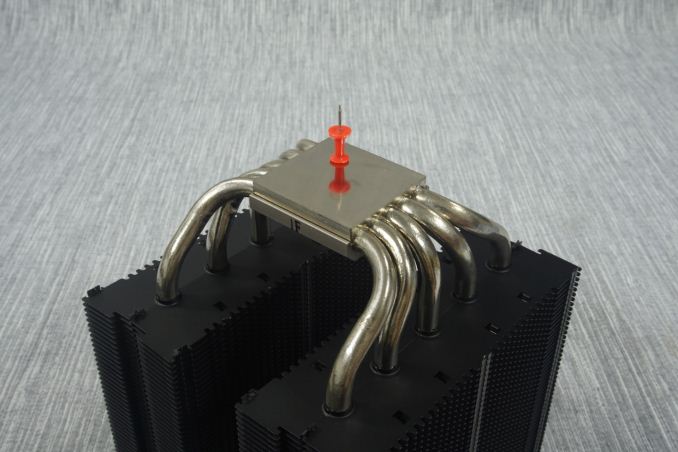








135 Comments
View All Comments
Peichen - Monday, July 6, 2015 - link
I expect many R9 Fury X users are shopping for large air-cooler now as they have to give up their AIO CPU-cooler to Fury.BTW, I really wish you added a Hyper 212X as reference.
meacupla - Monday, July 6, 2015 - link
You could just buy a case like the Fractal Design Define S, which could fit two separate 120mm CLLC in the front, allowing both to get fresh air.Flunk - Monday, July 6, 2015 - link
I'm a bit disappointed that you didn't comment on the install process on any of the heatsinks. I recently bought a Dark Rock Pro 3 and while I love how quiet it is and the temps are actually lower than the Corsair Hydro H80 it replaced, the install process requires you to screw the heatsink in from the back of the motherboard. That and the size of the supplied backplate made the heatsink install more difficult that is really necessary.If you buy a Dark Rock 3 Pro I recommend removing the motherboard from the case entirely and installing it by flipping the heatsink upside down and balancing the motherboard on top of it in the correct position. This makes it fairly easy to screw in. But if you are using a normal thermal paste you might need to put it on the heatsink instead of the CPU heatspreader. I use IC Diamond and that stuff is so thick that it just stuck there upside down for long enough to finish mounting the thing.
meacupla - Monday, July 6, 2015 - link
Yeah, this is actually quite important. Noctua's mounting brackets are, by far, one of the easiest to work with.'nar - Tuesday, July 7, 2015 - link
I never gave it much thought. Installation is such a small concern to me, maybe I do this more than most, price and performance are preferable. That said, I still think Noctua's mounting can be improved, it seems unnecessarily complicated to me. First off, you really do need to replace the plastic bracket, there's no way around that. But secondly, why include a 140mm screw driver? Why not make the screws 140mm taller? Then you can just use a common screw driver, even a stubby or a pocket knife. And make them captive so they do not fall out and you do not need to line them up. These will certainly add to the cost due to extra engineering time and unique screws.Beany2013 - Wednesday, July 8, 2015 - link
Because the 140mm screwdriver:A: Is cheaper than re-engineering the entire product
B: long screws are *very* easy to cross-thread due to the extra sideways torque you can apply when inserting them.
I *do* like the Noctua setup system. It's strong, comprehensive, and lets be honest, you only do it once. I'm pretty sure that any gotchas with installation were caught in the descriptions of each cooler, too.
der - Monday, July 6, 2015 - link
WOOOO!golemB - Monday, July 6, 2015 - link
For the Macho Zero especially, I'd want to see the tests conducted (additionally) in a vertical motherboard orientation (as you'd have in most tower cases), since convection may have an effect on performance. It may also reveal differences in fan noise due to bearings rubbing more or less on different surfaces.'nar - Tuesday, July 7, 2015 - link
Not likely. Convection is slow. Any fans will blow away convection currents. Besides, orientation is strictly a "case by case" basis and beyond the scope of an empirical HSF comparison.Fan noise due to orientation may be good to check for though. I doubt it will be any different, if it is, the aberration should be noted.
flashbacck - Monday, July 6, 2015 - link
wow, cpu cooler roundup! It seems so rare to see these nowadays.